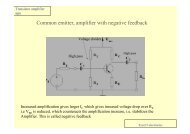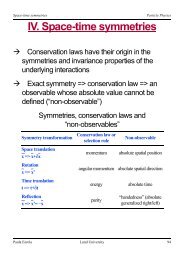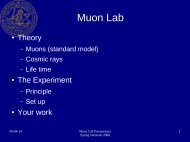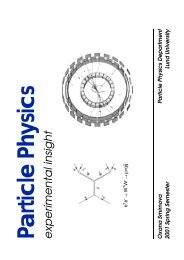Beyond the Standard Model - Particle Physics, Lund University
Beyond the Standard Model - Particle Physics, Lund University
Beyond the Standard Model - Particle Physics, Lund University
Create successful ePaper yourself
Turn your PDF publications into a flip-book with our unique Google optimized e-Paper software.
<strong>Beyond</strong> <strong>the</strong> <strong>Standard</strong> <strong>Model</strong><br />
V. Hedberg <strong>Beyond</strong> <strong>the</strong> <strong>Standard</strong> <strong>Model</strong> 1
The <strong>Standard</strong> <strong>Model</strong><br />
What is <strong>the</strong> standard model ?<br />
The standard model <strong>the</strong> electromagnetic, strong and weak<br />
interactions based on <strong>the</strong> principle of gauge invariance.<br />
Lots of free parameters:<br />
quark and neutrino mixing parameters,<br />
lepton and quark masses,<br />
coupling constants,<br />
W, Z and H masses...<br />
H<br />
Basic fermions and gauge bosons<br />
g<br />
W<br />
Z<br />
V. Hedberg <strong>Beyond</strong> <strong>the</strong> <strong>Standard</strong> <strong>Model</strong> 2
The <strong>Standard</strong> <strong>Model</strong><br />
The <strong>Standard</strong> <strong>Model</strong> agrees very well with all experimental data.<br />
The model has been tested down to 10 -18 m.<br />
It has been tested to a precision better than 0.1% .<br />
Does <strong>the</strong> Higgs exist ?<br />
Problems with <strong>the</strong> standard model:<br />
If neutrinos have mass, are <strong>the</strong>re right-handed neutrinos ?<br />
Why are <strong>the</strong>re 3 generations ?<br />
What about gravity ?<br />
V. Hedberg <strong>Beyond</strong> <strong>the</strong> <strong>Standard</strong> <strong>Model</strong> 3
The <strong>Standard</strong> <strong>Model</strong><br />
Why are <strong>the</strong> masses so different (<strong>the</strong> hierarchy problem) ?<br />
Can <strong>the</strong> strong and electroweak interaction be described by a<br />
unified <strong>the</strong>ory ?<br />
What happened with <strong>the</strong> anti-matter in <strong>the</strong> Big Bang ?<br />
What is dark matter ?<br />
What is dark energy ?<br />
V. Hedberg <strong>Beyond</strong> <strong>the</strong> <strong>Standard</strong> <strong>Model</strong> 4
Grand Unified Theories (GUTs)<br />
Weak and electromagnetic<br />
interactions are unified.<br />
add <strong>the</strong> strong one !<br />
Coupling constants are not<br />
truely constant<br />
<strong>the</strong>y depend on energy<br />
(or Q 2 )<br />
in <strong>the</strong> interaction.<br />
Unification at some very<br />
high unification mass<br />
electroweak and strong<br />
couplings become equal.<br />
The Georgi-Glashow model<br />
s<br />
W<br />
’<br />
Z<br />
’<br />
10 2 The Z-mass<br />
’<br />
g 2<br />
g W<br />
2<br />
W =<br />
4<br />
=8<br />
4<br />
=8 W<br />
g’ 2 2<br />
g<br />
Z<br />
’<br />
Z<br />
=<br />
4<br />
=8<br />
4<br />
=8 Z<br />
s = g s 2<br />
4<br />
U = g U 2<br />
4<br />
U<br />
10 15<br />
V. Hedberg <strong>Beyond</strong> <strong>the</strong> <strong>Standard</strong> <strong>Model</strong> 5
Grand Unified Theories (GUTs)<br />
Grand unified <strong>the</strong>ories constructed in many different ways.<br />
Example: The Georgi-Glashow model<br />
combines coloured quarks and leptons in single families<br />
(d r , d g , d b , e + , e )<br />
Two new gauge bosons are introduced<br />
X with Q=-4/3 and Y with Q=-1/3<br />
The gauge bosons have a mass close to <strong>the</strong> unification energy<br />
Extremly heavy: M X =10 15 GeV/c 2<br />
g2<br />
U<br />
Single unified coupling constant (g U ): U<br />
-------<br />
4<br />
1<br />
-----<br />
42<br />
V. Hedberg <strong>Beyond</strong> <strong>the</strong> <strong>Standard</strong> <strong>Model</strong> 6
Grand Unified Theories (GUTs)<br />
New gauge bosons processes possible in which quarks<br />
are transformed into leptons by exchanging X and Y bosons:<br />
old processes:<br />
d<br />
d<br />
g<br />
e +<br />
e<br />
W -<br />
new processes:<br />
d<br />
e +<br />
X<br />
d<br />
e<br />
Y<br />
The model predicts a value of U & relationship between<br />
g u , g and g’ it predicts a value for <strong>the</strong> weak mixing angle:<br />
2<br />
sin = 0.21<br />
W<br />
Close to <strong>the</strong> measured value !<br />
V. Hedberg <strong>Beyond</strong> <strong>the</strong> <strong>Standard</strong> <strong>Model</strong> 7
Grand Unified Theories (GUTs)<br />
Prediction <strong>the</strong> sum of <strong>the</strong> charges is zero within a family<br />
The number of colours<br />
(d r , d g , d b , e + , e )<br />
3Q d + e = 0<br />
Since d-quark have <strong>the</strong> charge -e/3 <strong>the</strong> model works !<br />
Baryon and lepton numbers are not necessarily conserved in GUT.<br />
Non-conservation why <strong>the</strong> world is dominated by baryons<br />
even if <strong>the</strong> same amount of baryons and anti-baryons were<br />
produced in <strong>the</strong> Big Bang.<br />
V. Hedberg <strong>Beyond</strong> <strong>the</strong> <strong>Standard</strong> <strong>Model</strong> 8
Proton decay experiments<br />
Grand Unified Theories<br />
The proton must be unstable !<br />
It decays by processes involving <strong>the</strong> X and Y bosons:<br />
p<br />
d<br />
u<br />
X<br />
e +<br />
e +<br />
d X<br />
p uu<br />
u<br />
u 0 u<br />
u 0<br />
Baryon and lepton numbers are not conserved in <strong>the</strong>se processes<br />
but <strong>the</strong> following combination is:<br />
B– L<br />
B– L <br />
(<br />
<br />
= e<br />
<br />
<br />
It is possible to estimate <strong>the</strong> lifetime of <strong>the</strong> proton ( p ) from<br />
a simple zero-range approximation:<br />
p = 10 32 – 10 33 years (Age of universe = 10 10 years)<br />
V. Hedberg <strong>Beyond</strong> <strong>the</strong> <strong>Standard</strong> <strong>Model</strong> 9
Proton decay experiments<br />
Many experiments that are doing neutrino physics (Kamiokande,<br />
IMB) started out as proton decay experiments.<br />
The most searched for decay mode p 0 + e+ + e+<br />
Look for one positron + two electron-positron pairs (from photon<br />
conversions).<br />
No proton decays have been observed upper limit:<br />
proton lifetime<br />
branching ratio =<br />
p<br />
32<br />
---------------------------- 510<br />
years<br />
Bp 0 e<br />
The Georgi-Glashow model predicts:<br />
proton lifetime<br />
branching ratio =<br />
0.003-0.030 x 10 32 years<br />
V. Hedberg <strong>Beyond</strong> <strong>the</strong> <strong>Standard</strong> <strong>Model</strong> 10
Supersymmetry<br />
Supersymmetry (SUSY) a GUT in which interactions are<br />
symmetric under <strong>the</strong> transformation of a fermion to a boson.<br />
Every known elementary particle have a super-symmetric partner<br />
(superpartner) with different spin.<br />
Spin = 1/2 1 0 0 1/2 1/2<br />
V. Hedberg <strong>Beyond</strong> <strong>the</strong> <strong>Standard</strong> <strong>Model</strong> 11
Supersymmetry<br />
The new particles are called squarks, sleptons, photinos, gluinos,<br />
winos, zinos ..... a tilde is used to denote <strong>the</strong>se particle: e<br />
New particles must be heavier than <strong>the</strong> known particles<br />
o<strong>the</strong>rwise <strong>the</strong>y would already have been discovered.<br />
The Lightest Supersymmetric <strong>Particle</strong> (LSP) is stable<br />
(in most SUSY models).<br />
New states are predicted due to mixing between some of <strong>the</strong><br />
super partner states:<br />
~ W ~ <br />
W ~<br />
H ~<br />
Z ~<br />
~<br />
<br />
<br />
<br />
<br />
<br />
<br />
<br />
“Charginos”<br />
“Neutralinos”<br />
V. Hedberg <strong>Beyond</strong> <strong>the</strong> <strong>Standard</strong> <strong>Model</strong> 12
Supersymmetry<br />
There are many different supersymmetric models:<br />
MSSM:<br />
Minimal<br />
super symmetric<br />
standard model<br />
cMSSM: Constrained<br />
MSSM<br />
mSUGRA: Minimal<br />
Supergravity<br />
AMSB:<br />
Name LSP New parameters<br />
Anomaly mediated<br />
symmetry breaking<br />
Any > 100<br />
<br />
~ <br />
<br />
<br />
~ <br />
<br />
<br />
~ <br />
<br />
M 0 , M 1/2 , A 0 , tan(), sgn()<br />
M 0 , M 1/2 , A 0 , tan(), sgn()<br />
m 0 , M 3/2 , tan(), sgn()<br />
GMSB:<br />
Gauge mediated<br />
symmetry breaking<br />
~ G m , M m , tan(), N 5 , sgn()<br />
V. Hedberg <strong>Beyond</strong> <strong>the</strong> <strong>Standard</strong> <strong>Model</strong> 13
Supersymmetry<br />
SUSY shift <strong>the</strong> grand unification energy to higher values.<br />
<strong>the</strong> prediction for <strong>the</strong> lifetime of <strong>the</strong> proton increases.<br />
1<br />
W<br />
’<br />
Extrapolation of <br />
W<br />
’<br />
to <strong>the</strong> unification<br />
scale works better<br />
1<br />
1<br />
s<br />
with SUSY. s<br />
1<br />
Z<br />
’<br />
<strong>Standard</strong><br />
<strong>Model</strong><br />
1<br />
1<br />
Z<br />
’<br />
SUSY<br />
SUSY predicts a value for <strong>the</strong> weak mixing angle which is closer<br />
to <strong>the</strong> experimental results than <strong>the</strong> Georgi-Glashow model.<br />
Some SUSY models unify ALL forces including gravity at <strong>the</strong><br />
Planck mass of 10 19 GeV by replacing particles with superstrings.<br />
V. Hedberg <strong>Beyond</strong> <strong>the</strong> <strong>Standard</strong> <strong>Model</strong> 14
Supersymmetry<br />
SUSY search in <strong>the</strong> DELPHI experiment<br />
SUSY at LEP Example: selectron production<br />
decay to electrons and neutralinos:<br />
e + + e - ẽ + + ẽ -<br />
e + + ˜ 0<br />
1<br />
-<br />
e ˜ – + 0<br />
1<br />
1) The cross section for producing selectron pairs is comparable<br />
to that of producing ordinary charged particles with <strong>the</strong> same<br />
mass.<br />
2) The selectrons decay before <strong>the</strong>y can reach a detector.<br />
3) The neutralinos only interact weakly and <strong>the</strong>y are <strong>the</strong>refore<br />
virtually undetectable.<br />
V. Hedberg <strong>Beyond</strong> <strong>the</strong> <strong>Standard</strong> <strong>Model</strong> 15
Supersymmetry<br />
Signature events with only an electron and a positron.<br />
Selection:<br />
i) <strong>the</strong> e + and e - should carry only half of <strong>the</strong> collision energy<br />
ii) <strong>the</strong> e + and e - are not emitted in <strong>the</strong> opposite directions<br />
No events were found with a clear and background free signature.<br />
The results set lower limits on <strong>the</strong> mass of <strong>the</strong> neutralino.<br />
SUSY has many models, each with different sets of unknown<br />
parameters <strong>the</strong> results are given for different assumptions<br />
on models and parameters.<br />
V. Hedberg <strong>Beyond</strong> <strong>the</strong> <strong>Standard</strong> <strong>Model</strong> 16
Supersymmetry<br />
The slepton searches were combined with o<strong>the</strong>r SUSY searches<br />
to set limits on <strong>the</strong> neutralino mass.<br />
All <strong>the</strong> coloured areas are<br />
excluded by <strong>the</strong> searches.<br />
The tan() parameter is<br />
related to <strong>the</strong> SUSY Higgs<br />
particles and m 0 to <strong>the</strong><br />
sfermions mass.<br />
Result:<br />
<br />
~ <br />
<br />
> 36.7 GeV<br />
for all parameter values.<br />
χ ∼ 0<br />
1 Mass (GeV/c 2 )<br />
1 10 40<br />
tanβ<br />
V. Hedberg <strong>Beyond</strong> <strong>the</strong> <strong>Standard</strong> <strong>Model</strong> 17<br />
60<br />
55<br />
50<br />
45<br />
40<br />
35<br />
30<br />
25<br />
20<br />
15<br />
10<br />
5<br />
0<br />
DELPHI χ ∼ 0<br />
1 limit (189-208) GeV<br />
m 0<br />
up to 1000 GeV/c 2 M t<br />
= 175<br />
38.7 GeV/c 2<br />
36.7 GeV/c 2<br />
PRELIMINARY<br />
m 0<br />
= 1000 GeV/c 2<br />
no mixing<br />
any m 0
Supersymmetry<br />
SUSY search in <strong>the</strong> ATLAS experiment<br />
One of <strong>the</strong> main purposes of <strong>the</strong> LHC experiments are to search<br />
for SUSY as predicted by different models.<br />
Promising channel:<br />
<strong>the</strong> production of a chargino & neutralino<br />
decays to leptons & lightest neutralino.<br />
Signature: three leptons<br />
(electrons & muons) and missing energy.<br />
<br />
p<br />
<br />
<br />
~<br />
<br />
1<br />
<br />
~<br />
0<br />
2<br />
<br />
~<br />
0<br />
1<br />
~<br />
0<br />
1<br />
p<br />
Selection:<br />
P T >10 GeV for <strong>the</strong> lepton & Missing energy > 30 GeV.<br />
Background: ZW and tt production.<br />
V. Hedberg <strong>Beyond</strong> <strong>the</strong> <strong>Standard</strong> <strong>Model</strong> 18
Gravitation and extra dimensions<br />
The gravitational force is much weaker than <strong>the</strong> electromagnetic<br />
and strong interactions not studied in particle physics.<br />
Postulated <strong>the</strong> existance of graviational force carriers<br />
Gravitons (G).<br />
Graviation has only been studied at large distances (>1 mm)<br />
it could be stronger at shorter distances.<br />
New <strong>the</strong>ories Gravity is unified with o<strong>the</strong>r interactions<br />
New dimensions of space in which only gravity can propagate<br />
(new dimensions in addition to <strong>the</strong> normal<br />
3 space + 1 time dimensions).<br />
V. Hedberg <strong>Beyond</strong> <strong>the</strong> <strong>Standard</strong> <strong>Model</strong> 19
Gravitation and extra dimensions<br />
Graviton search in <strong>the</strong> DELPHI experiment<br />
At <strong>the</strong> energy scale where gravity is unified with o<strong>the</strong>r forces<br />
gravitons are produced in high-energy collisions<br />
but escape undetected into <strong>the</strong> extra dimensions.<br />
¡¡¡<br />
Prediction: e + e - colliders with sufficient energy<br />
events with one graviton and one photon:<br />
e +<br />
γ e +<br />
γ e +<br />
γ<br />
e −<br />
G e −<br />
G e −<br />
G<br />
Gravitons cannot be detected<br />
only one photon in <strong>the</strong> experiment.<br />
V. Hedberg <strong>Beyond</strong> <strong>the</strong> <strong>Standard</strong> <strong>Model</strong> 20
Gravitation and extra dimensions<br />
Selections: Events with only one photon and nothing else.<br />
Measurement: The energy of <strong>the</strong> photon<br />
New<br />
<strong>Physics</strong><br />
Events/0.05<br />
0<br />
<strong>Standard</strong> <strong>Model</strong>:<br />
100<br />
√s ¬ = 190-200 GeV<br />
429 events obs.<br />
75<br />
452 events e +<br />
exp.<br />
50<br />
e + e<br />
n = 2<br />
γG<br />
25 M D = 0.75 TeV<br />
e -<br />
γ<br />
Z o<br />
ν<br />
ν<br />
<strong>Standard</strong><br />
<strong>Model</strong><br />
Events/0.05<br />
0<br />
100<br />
50<br />
√s ¬ = 200-210 GeV<br />
563 events obs.<br />
568 events exp.<br />
0<br />
0 0.2 0.4 0.6 0.8 1<br />
E γ<br />
⁄ E beam<br />
x γ<br />
Conclusion: No sign of graviton production in <strong>the</strong> data !<br />
V. Hedberg <strong>Beyond</strong> <strong>the</strong> <strong>Standard</strong> <strong>Model</strong> 21
Gravitation and extra dimensions<br />
The measurement set limits on <strong>the</strong> parameters in <strong>the</strong> <strong>the</strong>ory<br />
Parameters:<br />
i) n - <strong>the</strong> number of extra<br />
dimensions<br />
ii) M D - a fundamental<br />
mass scale.<br />
Limits:<br />
The data set limits on<br />
<strong>the</strong> cross section<br />
limits on M D and n in <strong>the</strong><br />
<strong>the</strong>ory<br />
Cross-section at 208 GeV (fb)<br />
10 4 e + e - →γ G DELPHI<br />
HPC+FEMC acceptance<br />
√s ¬ = 180-209 GeV<br />
10 3<br />
Predicted cross section<br />
for G if 2 extra dim.<br />
10 2<br />
95% C.L.<br />
Limit Limit<br />
n = 2<br />
M D<br />
= 1.31 TeV/c 2<br />
M D<br />
=<br />
10<br />
0.82 TeV/c 2<br />
M D<br />
= 0.58 TeV/c 2 n = 4<br />
n = 6<br />
1<br />
0.4 0.6 0.8 1 1.2 1.4 1.6 1.8 2<br />
M D<br />
(TeV/c 2 )<br />
V. Hedberg <strong>Beyond</strong> <strong>the</strong> <strong>Standard</strong> <strong>Model</strong> 22
Dark matter & energy<br />
The Big Bang <strong>Model</strong><br />
Experimental evidence for <strong>the</strong> Big Bang model<br />
1) A nearly uniform distribution<br />
of matter in <strong>the</strong> universe.<br />
2) An abundance of light<br />
elements such as He, D and<br />
Li.<br />
The Hubble<br />
.<br />
law:<br />
v = H 0 d<br />
3) The universe is expanding<br />
and <strong>the</strong> velocity of supernovas<br />
are <strong>the</strong>refore increasing<br />
with <strong>the</strong>ir distance to earth.<br />
4) The cosmic background radiation.<br />
The Hubble constant:<br />
H 0 = 71 (km/s) / Mpc<br />
2 billion<br />
lightyears<br />
V. Hedberg <strong>Beyond</strong> <strong>the</strong> <strong>Standard</strong> <strong>Model</strong> 23
Dark matter & energy<br />
The cosmic background radiation with a temperature of 2.7 K<br />
(0.0002 eV) remenant of <strong>the</strong> Big Bang.<br />
The sky as seen at microwave<br />
frequencies by <strong>the</strong> COBE<br />
satellite:<br />
The difference between <strong>the</strong> hottest regions in red and <strong>the</strong> coldest<br />
in blue are only 0.0002 K while <strong>the</strong> average temperature is 2.7 K.<br />
Conclusion: The cosmic microwave background radiation is very<br />
uniform.<br />
V. Hedberg <strong>Beyond</strong> <strong>the</strong> <strong>Standard</strong> <strong>Model</strong> 24
Dark matter & energy<br />
Hubble constant<br />
3H2<br />
0<br />
The critical density: ---------- c<br />
= = O10 8G<br />
– 26 kg m 3<br />
Gravitational constant<br />
If <strong>the</strong> density in <strong>the</strong> universe is larger than <strong>the</strong> critical density<br />
<strong>the</strong> expansion of <strong>the</strong> universe will eventually end.<br />
(o<strong>the</strong>rwise it will continue for ever).<br />
The relative density: <br />
c<br />
= M <br />
Matter part Energy part<br />
V. Hedberg <strong>Beyond</strong> <strong>the</strong> <strong>Standard</strong> <strong>Model</strong> 25
Dark matter & energy<br />
Dark Matter<br />
The inflationary Big Bang model<br />
<strong>the</strong> density is close to <strong>the</strong> critical density.<br />
Heavy Elements - 0.03%<br />
Neutrinos - 0.3%<br />
Most of <strong>the</strong> matter<br />
of an unkown type<br />
“Dark Matter”<br />
Stars - 0.5%<br />
Hydrogen & Helium - 4%<br />
Dark Matter - 25%<br />
Dark Energy - 70%<br />
V. Hedberg <strong>Beyond</strong> <strong>the</strong> <strong>Standard</strong> <strong>Model</strong> 26
Dark matter & energy<br />
Evidence for dark matter<br />
measurements of <strong>the</strong> rotation<br />
velocity of stars in galaxies.<br />
The large rotational velocity of<br />
stars in <strong>the</strong> outer regions of <strong>the</strong><br />
<strong>the</strong> Milky way<br />
<strong>the</strong> galaxy is full of dark matter.<br />
d<br />
v<br />
V. Hedberg <strong>Beyond</strong><br />
<strong>the</strong> <strong>Standard</strong> <strong>Model</strong> 27
Dark matter & energy<br />
What does dark matter consist of ?<br />
1) Baryonic matter that emits little or no electromagnetic<br />
radiation: Brown dwarfs, small black holes - MACHO’s<br />
(for Massive Compact Halo Object).<br />
2) Hot dark matter: If neutrinos have a mass > 1 eV<br />
give a significant contribution to <strong>the</strong> density of <strong>the</strong> universe.<br />
But it is difficult to explain how <strong>the</strong> galaxies are<br />
formed if neutrinos make up <strong>the</strong> dark matter.<br />
3) Cold dark matter: Weakly Interacting Massive <strong>Particle</strong>s<br />
(WIMPs). Non-baryonic objects that were non-relativistic<br />
at <strong>the</strong> early stages of <strong>the</strong> evolution of <strong>the</strong> universe.<br />
SUSY particles could be WIMPs.<br />
V. Hedberg <strong>Beyond</strong> <strong>the</strong> <strong>Standard</strong> <strong>Model</strong> 28
Dark matter & energy<br />
Dark Energy<br />
The brightness (magnitude) of remote supernovas and <strong>the</strong>ir<br />
redshifts <strong>the</strong> expansion of <strong>the</strong> universe is not constant<br />
but accelerating <strong>the</strong> universe is full of dark energy.<br />
Heavy Elements - 0.03%<br />
Neutrinos - 0.3%<br />
Stars - 0.5%<br />
Dark Matter:<br />
gravitationally<br />
attractive force<br />
Hydrogen & Helium - 4%<br />
Dark Matter - 25%<br />
Dark Energy - 70%<br />
Dark Energy:<br />
gravitationally<br />
repulsive force<br />
V. Hedberg <strong>Beyond</strong> <strong>the</strong> <strong>Standard</strong> <strong>Model</strong> 29
Dark matter & energy<br />
O<strong>the</strong>r evidence for<br />
dark energy<br />
studies of <strong>the</strong> Cosmic<br />
Microwave Background<br />
(CMB) & <strong>the</strong> motion<br />
of clusters in galaxies.<br />
<br />
M = 0.3<br />
{ = 0.7<br />
M<br />
V. Hedberg <strong>Beyond</strong> <strong>the</strong> <strong>Standard</strong> <strong>Model</strong> 30
Dark matter & energy<br />
What is causing <strong>the</strong> Dark Energy ?<br />
Two main hypo<strong>the</strong>sis:<br />
1) The Cosmological Constant: Space has an intrinsic constant<br />
fundamental energy (10 -29 g/cm 3 ). Calculations of vacuum<br />
fluctuations in particle physics give rise to an energy density<br />
in vacuum but <strong>the</strong> calculated value do not agree with<br />
astronomical observations.<br />
2) Quintessence: <strong>Particle</strong>-like excitations in a new dynamical field<br />
called quintessence. This field differs from <strong>the</strong> Cosmological<br />
constant in that it can vary in space and time.<br />
V. Hedberg <strong>Beyond</strong> <strong>the</strong> <strong>Standard</strong> <strong>Model</strong> 31
Dark matter & energy<br />
Direct search for WIMPs<br />
Interactions between WIMPs and matter has to be very rare.<br />
about one WIMP interacting in a kg of matter every day.<br />
WIMP detectors are installed<br />
deep underground and<br />
surrounded with shielding<br />
in order to minimize<br />
<strong>the</strong> background.<br />
The Boulby experiment:<br />
NaI detector which produces<br />
scintillation light if a WIMP<br />
interacts with an atom.<br />
200 tons of ultra pure water is used for shielding.<br />
V. Hedberg <strong>Beyond</strong> <strong>the</strong> <strong>Standard</strong> <strong>Model</strong> 32
Dark matter & energy<br />
The Cryogenic Dark Matter Search (CDMSII)<br />
In 2009, CDMSII claimed “a hint”<br />
of a dark matter discovery.<br />
CDMSII: Ge detectors at<br />
<strong>the</strong> Soudan underground<br />
laboratory to look for WIMPs.<br />
Interactions between WIMPs and<br />
<strong>the</strong> Ge atoms phonons and<br />
ionization detected by sensors<br />
on <strong>the</strong> semiconductors.<br />
Two candidate events with 0.9 expected<br />
from background.<br />
V. Hedberg <strong>Beyond</strong> <strong>the</strong> <strong>Standard</strong> <strong>Model</strong> 33












